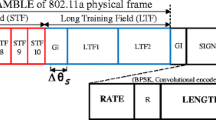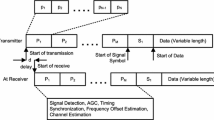Abstract
Clock synchronization is one of the most crucial and fundamental issues in distributed networks. Inaccurate factors in synchronizing clocks between nodes in the network can occur at any point in the network layers. Most uncertainties caused at the upper layers can be eliminated by hardware-assisted time stamping. However, eliminating the uncertainty of a physical layer is difficult.
This paper proposes a multi-phase correlator-based clock synchronization method to mitigate the time representation error at the physical layer and improve synchronization accuracy by introducing a time representation error, which is one of physical uncertainties. Further, to apply the proposed method to a realistic environment, we implement and evaluate the proposed multi-phase correlator. Our experimental results show that the accuracy of the proposed method is better than that of a conventional approach in terms of minimizing the time representation error.














Similar content being viewed by others
References
Akkaya, K., & Younis, M. (2005). A survey on routing protocols for wireless sensor networks. Ad Hoc Networks, 3(3), 325–349.
Cho, H., Jung, Y., Cho, B., Jin, Y., Lee, S., & Baek, Y. (2009). Precision time synchronization using IEEE 1588 for wireless sensor network. In International conference on computational science and engineering.
Cho, H., Kim, J., & Baek, Y. (2011). Enhanced precision time synchronization for wireless sensor networks. Sensors, 11(8), 7625–7643.
Cox, D., Jovanov, E., & Milenkovic, A. (2005). Time synchronization for Zigbee networks. In Proceedings of the 37th annual southeastern symposium on system theory (pp. 135–138).
Dai, H., & Han, R. (2004). Tsync: a lightweight bidirectional time synchronization service for wireless sensor networks. Mobile Computing and Communications Review, 8, 125–139.
Elson, J., Girod, L., & Estrin, D. (2002). Fine-Grained network time synchronization using reference broadcasts. In The fifth symposium on operating systems design and implementation (OSDI) (pp. 147–163).
Elson, J., & Romer, K. (2003). Wireless sensor networks: a new regime for time synchronization. Computer Communication Review, 33(1), 149–154.
Ganeriwal, S., Kumar, R., & Srivastava, M. B. (2003). Timing-sync protocol for sensor networks. In Proceedings of the ACM international conference on embedded networked sensor systems (pp. 138–149).
IEEE 802.15.4 (2003). Wireless Medium Access Control (MAC) and Physical Layer (PHY) Specifications for Low-Rate Wireless Personal Area Networks (LR-WPANs), IEEE Computer Society.
Koo, B., Han, K., Park, J. J., & Shon, T. (2011). Design and implementation of a wireless sensor network architecture using smart mobile devices. Telecommunication Systems. Online first.
Kusy, B., Dutta, P., Levis, P., Maroti, M., Ledeczi, A., Culler, & Elapsed, D. (2006). Time on Arrival: A simple and versatile primitive for canonical time synchronization services. International Journal of Ad Hoc and Ubiquitous Computing, 239–251.
Maroti, M., Kusy, B., Simon, G., & Ledeczi, A. (2004). The flooding time synchronization protocol. In Proceedings of the ACM international conference on embedded networked sensor systems (pp. 39–49).
Palchaudhuri, S., Saha, A. K., & Johnsin, D. B. (2004). Adaptive clock synchronization in sensor networks. In Proceedings of the international symposium on information processing in sensor networks.
Ren, F., Lin, C., & Liu, F. (2008). Self-correcting time synchronization using reference broadcast in wireless sensor network. IEEE Wireless Communications, 15(4), 79–85.
Royo, F., Olivares, T., & Orozco-Barbosa, L. A synchronous engine for wireless sensor networks. Telecommunications Systems, 40(3–4), 151–159.
Sheu, J., Hu, W., & Lin, J. (2008). Ratio-based time synchronization protocol in wireless sensor networks. Telecommunications Systems, 39(1), 25–35.
Song, P., Shan, X., Li, K., & Qi, G. (2009). Highly precise time Synchronization Protocol for ZigBee networks. IEEE/ASME International Conference on Advanced Intelligent Mechatronics 2009 (AIM2009).
Stoyanova, T., Kerasiotis, F., Prayati, A., & Papadopoulos, G. (2009). Evaluation of impact factors on RSS accuracy for localization and tracking applications in sensor networks. Telecommunications Systems, 42(3–4), 235–248.
U.S. Department of Homeland Security (DHS) (2007). Conveyance Security Device (CSD) Requirements, Baseline Version 3.0, http://www.dhs.gov.
Weibel, H., & Bechaz, D. (2004). IEEE 1588 implementation and performance of time stamping techniques. In 2004 conference on IEEE 1588.
Xiao, Y., & Zhang, Y. (2011). Design and implementation of a wireless sensor network architecture using smart mobile devices. Telecommunication Systems. Online first.
Ye, Q., Zhang, Y., & Cheng, L. (2005). A study on the optimal time synchronization accuracy in wireless sensor networks. Journal of Computer Networks and Communications, 48, 549–566.
Acknowledgements
This work was supported by the Center for Integrated Smart Sensors funded by the Ministry of Science, ICT & Future Planning as Global Frontier Project (CISS-2012054192).
Author information
Authors and Affiliations
Corresponding author
Rights and permissions
About this article
Cite this article
Cho, H., Jang, H. & Baek, Y. Multi-phase correlator-based realistic clock synchronization for IEEE 802.15.4 networks. Telecommun Syst 55, 377–386 (2014). https://doi.org/10.1007/s11235-013-9798-7
Published:
Issue Date:
DOI: https://doi.org/10.1007/s11235-013-9798-7




